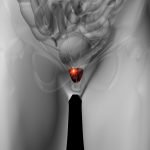Leaky Gut: Is There a Test for That?
Alisun Bonville, ND
Docere
Leaky gut, ie, increased intestinal permeability, is a term that gets a lot of attention on health blogs and advertisements these days. Many Americans are curious about increased intestinal permeability and believe it to be a contributing factor to their health issues. Leaky gut can be defined as increased intestinal permeability, or a functional intestinal disorder at the site of nutrient absorption, known as the brush border, in the proximal small intestine. The causes of increased intestinal permeability are numerous, including intestinal infections, small intestinal bacterial overgrowth (SIBO) and bacterial dysbiosis, food allergies and intolerances, non-steroidal anti-inflammatory drug (NSAID) usage, stress, low stomach acid, and high intake of sugar or alcohol. The symptoms of leaky gut are also wide-ranging and are often related to other comorbidities, such as irritable bowel syndrome (IBS) and gastrointestinal (GI) infections. In most clinical settings, leaky gut is not considered a standalone diagnosis, and is often investigated as an underlying cause of other diagnoses.
Increased intestinal permeability has been implicated in many chronic diseases, including cancer, autism, and autoimmune diseases. Increased intestinal permeability is also a frequent cofactor in other GI illnesses, such as inflammatory bowel disease (IBD), IBS, and SIBO.
Currently, there is no clear gold-standard, reliable, cost-effective, and easy-to-perform laboratory evaluation for increased intestinal permeability; instead, it has primarily been a clinical diagnosis. This article aims to educate practitioners about effective ways to evaluate for increased intestinal permeability. Toward that end, we will examine the various diagnostic markers currently available, and discuss them in light of the pathophysiology of leaky gut.
Intestinal Permeability – A Review
The small intestinal lining is a single-celled mucosal layer that is the body’s largest and most important mucous membrane surface. GI inflammation and damage to the brush border allow molecules to “leak” directly into the gut-associated lymphoid tissue (GALT) and bloodstream, which activates the immune system. Damage to the brush border can result in poor nutrient absorption, bacterial dysbiosis, and inflammation, all of which can be contributing factors in many chronic disease processes, including:
- All autoimmune diseases (eg, celiac disease, rheumatoid arthritis, lupus, type 1 diabetes)
- Endocrine diseases (eg, polycystic ovary syndrome, type 2 diabetes)
- Neurological disorders (eg, Parkinson’s disease, multiple sclerosis, schizophrenia)
- Cardiovascular disease
- Allergies and asthma
- All GI disorders (eg, IBS, Crohn’s disease, ulcerative colitis, celiac disease)
- Neoplastic disease
- Inflammatory diseases (eg, arthritis and other causes of joint pain)
- Chronic infections
The intestinal barrier acts to absorb nutrients and water via 2 distinct mechanisms: intra/transcellular absorption and paracellular absorption. These mechanisms rely on a system of complex cellular proteins. When functioning properly, the intracellular transport system and tight paracellular junctions ensure that only appropriate molecules, such as water and nutrients, can pass into the GALT and the bloodstream. The mechanism of transcellular absorption relies on either gradient-based transportation or membrane-driven active transport to bring molecules in and out of the intestinal cells. Paracellular transport uses the actin-myosin cytoskeletal system and 3 paracellular structures called desmosomes, adherins junctions, and tight junctions, to prevent or allow passage of molecules between the intestinal cells.1 It is believed that smaller molecules pass through the intestinal barrier via active transport trancellularly, while larger molecules will pass paracellularly.
Much research has focused on the particular importance of the paracellular transport mechanisms and their role in increased intestinal permeability. The paracellular proteins were originally thought to act like cement, tightly adhering the intestinal cells together at all times to create a snug intestinal barrier. We now know that the tight junction is a dynamic space that can adapt to the body’s absorption needs. The paracellular junctions between the intestinal cells dramatically change in size in response to the modulator, zonulin, with the tight junctions being the most sensitive to this protein.2
Zonulin
Zonulin regulates these tight junctions in the small intestine by acting on the cytoskeleton structure, actomyosin, which changes in size to create paracellular space to accommodate macromolecules – a result of physiological or pathological stimulation.2 Zonulin secretion is induced by the presence of pathogenic bacteria, gliadin, and celiac disease.2 Intestinal permeability rapidly increases in response to zonulin, potentially causing an influx of large macromolecules past the barrier. This action is quick and reversible.3 On the other side of the intestinal barrier is the GALT, ready to respond to molecules that require action by the immune system. In a healthy small intestine, the GALT assists in promoting tolerance rather than immune activation. In a pathological situation, the GALT may instead mount an immune response against antigens. Zonulin can be measured in a blood test. Elevated levels of zonulin indicate increased intestinal permeability and a compromised brush border.2
LPS Antibodies
One molecule that may access the GALT when zonulin is elevated is lipopolysaccharide (LPS). LPS is a membrane component of gram-negative enteric bacteria, which can increase pro-inflammatory cytokines when at high amounts in the blood.4 An intact brush border prevents LPS from interacting with the GALT, thereby reducing the risk of systemic inflammation. LPS antibodies found in the blood reflect GALT interaction with LPS, thus can serve as a useful marker in identifying leaky gut and its severity.5
Actomyosin Antibodies
When the tight junctions are compromised, the actomyosin component becomes exposed. Recall that actomyosin holds the tight junctions together. When the tight junctions begin leaking, exposed actomyosin may trigger antibody production to the degrading actomyosin. These antibodies to actomyosin are easily measured in the blood and may be a valuable marker for detecting mucosal damage that can lead to increased intestinal permeability.6
Lactulose/Mannitol Test
An older test for intestinal permeability is the lactulose and mannitol (or rhamnose) urinary excretion test.7 Rather than directly measure intestinal permeability, this test reflects the amount and ratio of non-metabolized large (lactulose) and small (mannitol or rhamnose) sugars that are passively absorbed in the intestines and excreted in the urine. Lactulose is thought to mostly reflect paracellular absorption, whereas mannitol or rhamnose reflects mostly transcellular absorption.8 Higher absorption of these sugars is commonly found in individuals with Crohn’s/IBD or celiac disease, and in users of NSAIDs, which tend to increase GI permeability.9 The lactulose/mannitol test has been considered the standard test for assessing GI permeability over at least the past decade; however, rates of excretion can vary greatly depending on sugar dosage, timing of collection, individual patterns of excretion, and NSAID intake.9 Due to this variability, other tests markers for intestinal permeability may be more accurate.
Anti-CdtB & Anti-Vinculin Abs
Anti-CdtB (cytolethal distending toxin B) and anti-vinculin antibody testing is currently being used to diagnose IBS-D (diarrhea-predominant IBS) by distinguishing it from IBD. Given the frequent association between IBS and increased intestinal permeability, these antibody tests may be useful for evaluating intestinal permeability as well. CdtB is a toxin produced by many pathogenic bacteria that cause acute gastroenteritis.10 Vinculin is a cytoplasmic protein that is important in cell signaling and adhesion in many tissues, including the small intestine.11
Frequently, after an acute GI illness, the body can develop antibodies to CdtB that may cross-react with the host cell adhesion protein, vinculin, though molecular mimicry.12 The antibodies to CdtB may clear the toxin, but remain in circulation and cross-react with vinculin in the intestinal lining; this can continue to cause damage long after the aggravating factor is gone. Increased levels of anti-CdtB have been demonstrated to indicate the presence of IBS-D; these markers may also indicate concomitant increased intestinal permeability.12 In addition, levels of circulating antibodies to CdtB and vinculin were shown in a rat model to correlate with a diagnosis of SIBO.10 While anti-vinculin and anti-CtdB have not been evaluated for diagnosing leaky gut, to this author’s knowledge such studies could be informative, as anti-CtdB and anti-vinculin levels appear to be useful in evaluating both severity and causative factors of increased intestinal permeability.
Summary
Using specific lab markers to evaluate increased intestinal permeability can be very useful in an individual who has digestive upset, diarrhea, or chronic constipation. The above-mentioned markers not only help to differentiate IBS from IBD, celiac disease, and other digestive problems, but also offer insight into chronic disease etiologies. Indeed, many sufferers of GI illnesses that test negative for organic causes of GI disease despite being symptomatic often feel a sense of relief when told the underlying cause of their chronic illness, or even GI symptoms such as constipation, diarrhea, or abdominal pain, is leaky gut. While no test is yet considered a clear gold standard for leaky gut, together the above tests can successfully diagnose increased intestinal permeability and thereby point a clinician toward appropriate treatment.
References:
- Groschwitz KR, Hogan SP. Intestinal barrier function: molecular regulation and disease pathogenesis. J Allergy Clin Immunol. 2009;124(1):3-20.
- Fasano A. Physiological, pathological, and therapeutic implications of zonulin-mediated intestinal barrier modulation: living life on the edge of the wall. Am J Pathol.2008;173(5):1243-1252.
- Fasano A. Zonulin and its regulation of intestinal barrier function: the biological door to inflammation, autoimmunity, and cancer. Physiol Review. 2011;91(1):151-175.
- Guo S, Al-Sadi R, Said HM, Ma TY. Lipopolysaccharide causes an increase in intestinal tight junction permeability in vitro and in vivo by inducing enterocyte membrane expression and localization of TLR-4 and CD14. Am J Pathol. 2013;182(2):375-387.
- Bischoff SC, Barbara G, Buurman W, et al. Intestinal permeability–a new target for disease prevention and therapy. BMC Gastroenterol. 2014;14:189.
- Vojdani A. For the Assessment of Intestinal Permeability, Size Matters. Altern Ther Health Med. 2013;19(1):12-24.
- Hollander D. Intestinal permeability, leaky gut, and intestinal disorders. Curr Gastroenterol Rep.1999;1(5):410-416.
- Grootjans J, Thuijls G, Verdam F, et al. Non-invasive assessment of barrier integrity and function of the human gut. World J Gastrointest Surg. 2010;2(3):61-69.
- Sequeira IR, Lentle RG, Kruger MC, Hurst RD. Standardising the Lactulose Mannitol Test of Gut Permeability to Minimize Error and Promote Comparability. PLoS One. 2014;9(6):e99256. Available at: http://journals.plos.org/plosone/article?id=10.1371/journal.pone.0099256. Accessed October 10, 2017.
- Pimentel M, Morales W, Pokkunuri V, et al. Autoimmunity Links Vinculin to the Pathophysiology of Chronic Functional Bowel Changes following Campylobacter jejuni Infection in a Rat Model. Dig Dis Sci. 2015;60(5):1195-1205.
- Carisey A, Ballestrem C. Vinculin, an adapter protein in control of cell adhesion signalling. Eur J Cell Biol. 2011;90(2-3):157-163.
- Pimentel M, Morales W, Rezaie A, et al. Development and validation of a biomarker for diarrhea-predominant irritable bowel syndrome in human subjects. PLoS One. 2015;10(5):e0126438.
Image Copyright: <a href=’https://www.123rf.com/profile_guniita’>guniita / 123RF Stock Photo</a>
 Alisun Bonville, ND, received her doctorate in naturopathic medicine from NUNM in Portland, OR, in 2009. Dr Bonville practiced for 3 years in Portland before returning to her home state of Montana. She is the owner, medical director, and resident director at Spring Integrative Health in Bozeman, MT. It is a thriving private practice that focuses on neuroendocrine disorders and digestive health. Dr Bonville has a passion for combining conventional and functional medicine with authentic nature-cure. In her free time, she is pursuing a Level-1 teacher training in Kundalini yoga, and loves spending time in the MT wilderness with her 2 sons and husband.
Alisun Bonville, ND, received her doctorate in naturopathic medicine from NUNM in Portland, OR, in 2009. Dr Bonville practiced for 3 years in Portland before returning to her home state of Montana. She is the owner, medical director, and resident director at Spring Integrative Health in Bozeman, MT. It is a thriving private practice that focuses on neuroendocrine disorders and digestive health. Dr Bonville has a passion for combining conventional and functional medicine with authentic nature-cure. In her free time, she is pursuing a Level-1 teacher training in Kundalini yoga, and loves spending time in the MT wilderness with her 2 sons and husband.








